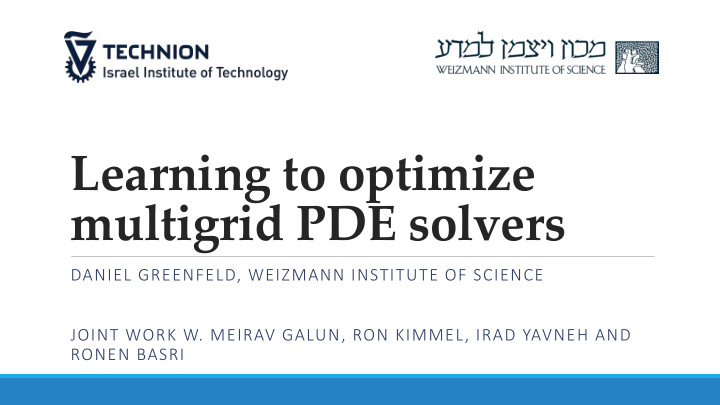



Learning to optimize multigrid PDE solvers DANIEL GREENFELD, WEIZMANN INSTITUTE OF SCIENCE JOINT WORK W. MEIRAV GALUN, RON KIMMEL, IRAD YAVNEH AND RONEN BASRI
Solving PDEs is useful ◦ Predicting weather systems ◦ Aircraft and auto design ◦ Oceanic flow
Solving PDEs is hard ◦ High accuracy requires discretization on very fine grids ◦ Developing efficient solvers is an active research area since many decades ago ◦ Can we use machine learning to construct solvers?
Previous works L earning to solve a single equation (new equation = retrain needed) ◦ Katrutsa et al, 2017: learning the prolongation for Poisson equation ◦ Hsieh, 2019: accelerate Poisson solvers ◦ Baque et al, 2018: simulate fluid dynamics ◦ Han et al, 2018: PDEs in high dimension ◦ ...
This work ◦ Learning how to solve a family of PDEs ◦ Example: 2D elliptic diffusion problems −𝛼 ⋅ 𝛼𝑣 = 𝑔 ◦ Focus on multigrid solvers ◦ Solves the equation on multiple scales ◦ Prolongation operator for moving between scales
Key elements of our approach ◦ Scope - train a single network once for an entire class of PDEs ◦ Unsupervised training - no ground truth provided, and no equation is solved during training ◦ Generalization - train on small problems w. periodic BC & test on much larger problems w. Dirichlet BC ◦ Efficient training – using Fourier analysis
TL;DR o We pose the following learning problem min 𝜄 𝔽 𝐵~𝐸 𝜍 𝑁 𝐵, 𝑄 𝜄 𝐵 o 𝜍 𝑁 𝐵, 𝑄 𝜄 𝐵 measures the convergence rate of the solver o 𝑄 𝜄 (𝐵) is a NN mapping PDEs (discretization matrices) to multigrid solvers (prolongation operators) o 𝐵~𝐸 is a distribution over PDEs (for example, a distribution over in −𝛼 ⋅ 𝛼𝑣 = 𝑔)
Some results Grid size V cycle W cycle 32x32 83% 100% 64x64 92% 100% 128x128 91% 100% 256x256 84% 99% 512x512 81% 99% 1024x1024 83% 98%
If interested, come check out our poster @ Pacific Ballroom #249
Recommend
More recommend